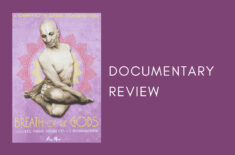If you’re a Yogi who’s looking to deepen your practice, increase yogic wisdom, and expand your sense of self, then the Yoga Sutras should be on your study list.
Thanks to the rise in popularity of yoga styles like Ashtanga, Vinyasa, and Bikram, most of us don’t dive into yoga philosophy unless we go through yoga teacher training or stumble upon it on our own quest.
For many of us, yoga practice starts focusing on physical activity rather than mental or even spiritual development.
The health benefits of yoga’s physical practice are undeniable: balanced nervous system function, lower blood pressure, decreased stress hormones, better sleep, and improved digestion, to name a few.
And we can gain even more mental and emotional health benefits when we apply aspects of yoga philosophy into our daily lives.
What are the Yoga Sutras of Patanjali?
Over 2,000 years ago, an Indian philosopher and sage called Patanjali codified and systemized Yoga’s teachings into a sacred text known as the Yoga Sutras.
The Yoga Sutras are considered the most authoritative text of the Classical Yoga period.
The history of yoga is characterized by six major periods spanning over five thousand years:
1 – Pre-Vedic Period – Little is known about this first period except that it began in the Indus Valley, India.
2 – Vedic Period – The Vedas are the most ancient Hindu scriptures and contain the oldest known Yogic teachings (Vedic Yoga) centered around transcending the visible material world and the mind’s limitations.
3 – Pre-classical period – The Upanishads and the Bhagavad Gita were created during this period. Both of these texts were seminal works in Hinduism and Yoga studies.
4 – Classical period – The creation of the Yoga Sutras and the eight-limbed Yogic path known as Raja Yoga.
5 – Post-Classical Period – Tantra yoga and Hatha yoga were created here.
6 – Modern Yoga period – Also known as the Western Yoga Period or Postural Modern Yoga because this was when Yoga expanded out into the United States and other countries. This time led to the creation of Vinyasa and other more commonly known yoga styles.
What does ‘sutra’ mean?
In Sanskrit literature, Yoga tradition, and Buddhist philosophy, sutras are aphorisms or memorable expressions of general truths or principles.
The word sutra means “thread.”
With each sutra, Patanjali attempted to weave yogic knowledge into a few words or syllables so that students would learn and memorize them.
How many yoga sutras are there?
There are 196 aphorisms organized into four chapters. Each sutra forms a short statement.
What are the four sutra chapters?
Samadhi Pada (Chapter on Contemplation)
Contains 51 sutras that outline the objective and definition of Yoga and the obstacles to achieving the objective of yoga (Kleshas).
This chapter also discusses the importance of constant, never-ending practice (Abhyasa) and detachment (Vairagya) in order to achieve the highest yoga and life goals.
Sadhana Pada (Chapter on Practice)
Contains 55 sutras centered around the actual practice of yoga.
Here Patanjali discusses Kriya Yoga (the yoga of action), the concept of karma, and also outlines the eight limbs of yoga.
Vibhuti Pada (Chapter on Accomplishments)
Contains 56 sutras outlining the by-products or accomplishments of constant yoga practice.
According to Patanjali, these accomplishments come with the practice of yoga’s final three limbs – one-pointed focus, meditation, and absolute calm.
Kaivalya Pada (Chapter on Transcendence)
These last 34 sutras discuss the concept of Kaivalya, a state of total awareness that leads to transcendence and liberation.
Kaivalya releases us from the bondage of misperceptions, unresolved emotional traumas, judgments, triggers, and limiting beliefs.
What are the Eight Limbs of Yoga?
The sage Patanjali codified Yoga teachings into what’s known as the eight limbs of yoga or Ashtanga yoga.
Practicing this eight-limbed yoga can help you:
- Awaken deeper understanding, insight, & intuition.
- Cultivate the quality of calm inner balance regardless of outer circumstances.
- Grow inner strength and resilience.
Think of the Eightfold Path as a roadmap and a blueprint for living in the world with more peace, meaning, inspiration, well-being, and mental power.
It involves “being” practices as well as “doing” practices:
1 – The Yamas (Self-Regulating behaviors)
There are five self-regulating behaviors:
1.1 – Ahimsa (non-violence, benevolence)
1.2 – Satya (Honoring your truth, truthfulness)
1.3 – Asteya (Even-exchange, non-stealing)
1.4 – Aparigraha (Detachment from the outcome)
1.5 – Brahmacharya (Self-control)
2 – The Niyamas (Personal Disciplines)
There are five personal disciplines:
2.1 – Saucha (Cleanliness and purity)
2.2 – Santosha (Contentment, gratitude)
2.3 – Tapas (Cultivating discipline and endurance through pain and heat)
2.4 – Svadhyaya (Self-study, self-inquiry, and study of ancient texts)
2.5 – Ishvara Pranidhana (Surrender to a higher power)
3 – Asana (Meditational postures)
4 – Pranayama (Breath-control and regulation of vital energy or prana)
5 – Pratyahara (Sense control, drawing attention away from the external world towards the internal world)
6 – Dharana (Sustained one-pointed focus and concentration)
7 – Dhyana (Meditation)
8 – Samadhi (Self-realization, Transcendence, Inner Calm)
What is the goal of Yoga according to the Sutras?
“This is the teaching of Yoga. (1)
Yoga is the cessation of the turnings of thought. (2)
When thought ceases, the spirit stands in its true identity as an observer to the world. (3)
Otherwise, the observer identifies with the turnings of thought. (4)”
– Sutras 1.1-4, Yoga: Discipline of Freedom, Barbara Stoler Miller
Patanjali wastes no time defining the ultimate goal of yoga.
In Sutra 1.2 he defines yoga as the stilling of mental chatter (citta vritti).
Then, the goal of yoga is to quiet the fluctuations of the mind so one can cultivate mindfulness, stillness, and self-awareness.
This is the first step towards achieving higher states of consciousness.
Like a serene lake allows you to clearly see the image of its surroundings clearly reflected on its motionless waters, so too does the mind reflect you your true self when mental noise goes quiet.
This is the beginning of self-realization and transcendence of the limited self (Samadhi).
CWY Recommended Yoga Sutra Books
1 – Yoga: Discipline of Freedom by Dr. Barbara Stoler Miller
Stoler Miller’s translation of the Sutras brings a fresh Western approach that makes the text more accessible and easily understandable for today’s modern life.
The result is a comprehensive yet practical translation that anyone can follow and start applying to their life today.
Stoler Miller held a doctorate in Sanskrit and Indic studies and taught Asian & Middle Eastern Cultures at Barnard College, Columbia University, for 25 years.
2 – Light On The Yoga Sutras by B.K.S. Iyengar
Written by the world-renowned yoga teacher, founder of Iyengar yoga, and author of “Light On Yoga,” B.K.S. Iyengar gives a detailed and thorough explanation and background of not just the Yoga Sutras but also the philosophy behind the teachings.
This results in a well-rounded understanding of the sutras and the “bigger picture” of yoga practice in general.
Each sutra features its Sanskrit version, a direct translation of each word, translation of the entire sutra, and added tables and charts for deeper understanding.
3 – The Yoga Sutras of Patanjali by Sri Swami Satchidananda
This translation is one of the most widely used in yoga teacher training and yoga philosophy studies.
Swami Satchidananda was the founder of the Integral Yoga Institute and the Yogaville ashram.
This version features the actual Sanskrit words, and each word has its own translation.
The entire sutra is also translated, and his commentary follows.
4 – The Heart of Yoga: Developing A Personal Practice by T.K.V. Desikachar
This book is a complete how-to guide for developing your home yoga practice.
Its author, Desikachar, was the son of the “Father of Modern Yoga,” Tirumalai Krishnamacharya.
The book details everything you need to practice the eight limbs – from asana practice, counterposes, sequences, breathing exercises, meditation, and philosophy.
It also features a translation of the Yoga Sutras and a short commentary for each one.

















